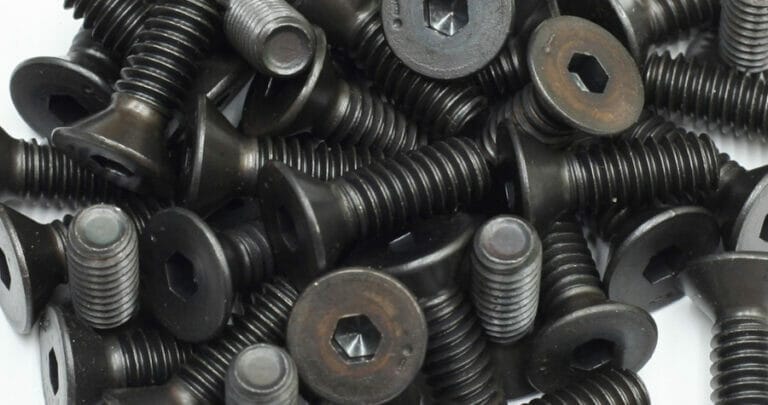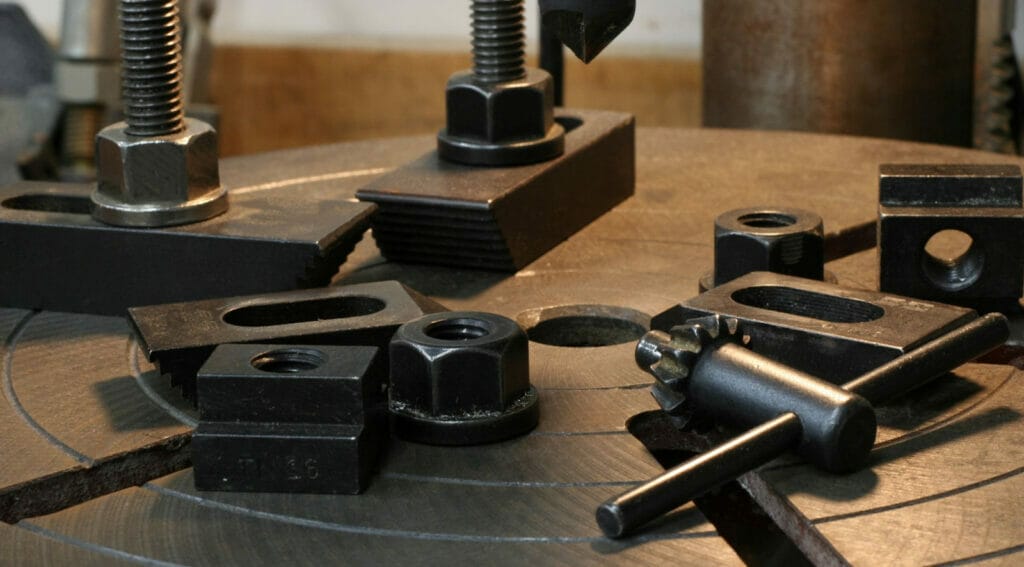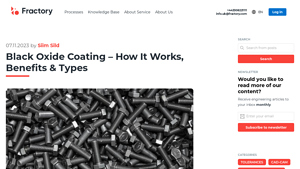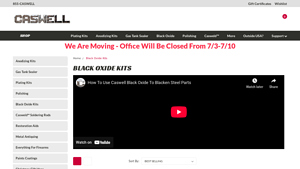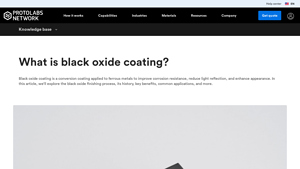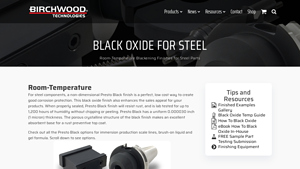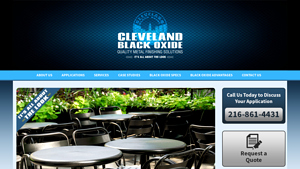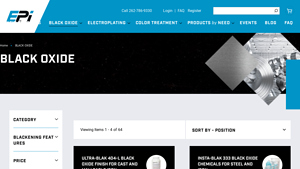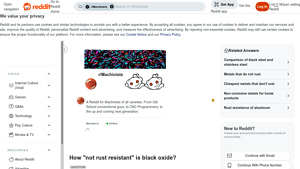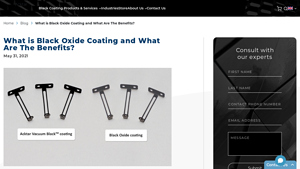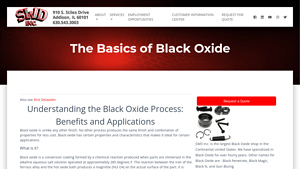Black Oxide Steel Guide: Type, Cost, Top List…
Introduction: Navigating the Global Market for black oxide steel
In the competitive landscape of industrial manufacturing, sourcing black oxide steel presents unique challenges for B2B buyers. This versatile material, known for its enhanced corrosion resistance and aesthetic appeal, is essential across various sectors, including automotive, aerospace, and hardware production. However, navigating the complexities of black oxide steel—such as understanding the different coating processes, assessing supplier credibility, and evaluating cost-effectiveness—can be daunting, especially for businesses in regions like Africa, South America, the Middle East, and Europe, including Saudi Arabia and Nigeria.
This comprehensive guide aims to demystify the global market for black oxide steel by delving into its various types, applications, and the nuances of the coating process. We will also explore critical factors to consider when vetting suppliers, ensuring you secure high-quality products that meet your specifications. Additionally, we will provide insights into pricing structures and cost-saving strategies, empowering you to make informed purchasing decisions.
By leveraging the information in this guide, international B2B buyers can enhance their procurement strategies, ensuring they source the right black oxide steel solutions tailored to their operational needs. Equip yourself with the knowledge necessary to thrive in today’s dynamic market and elevate your business’s competitive edge.
Understanding black oxide steel Types and Variations
| Type Name | Key Distinguishing Features | Primary B2B Applications | Brief Pros & Cons for Buyers |
|---|---|---|---|
| Hot Black Oxide Process | Conducted at high temperatures (141 °C), creates a durable magnetite layer. | Automotive parts, aerospace, tools | Pros: Excellent corrosion resistance, suited for large batches. Cons: Risk of steam explosion, requires careful handling. |
| Mid-Temperature Black Oxide | Operates between 90 °C and 120 °C, less toxic fumes than hot process. | Hand tools, fasteners | Pros: Safer than hot process, suitable for various applications. Cons: May not achieve as deep a black finish as hot process. |
| Cold Black Oxide Process | Conducted at room temperature, does not convert surface to oxide. | Decorative items, low-stress parts | Pros: Cost-effective, easy to apply. Cons: Limited corrosion resistance compared to hot and mid-temperature processes. |
| Presto Black Finish | Low-cost, room-temperature application with a porous crystalline structure. | Low-volume production, prototypes | Pros: Good corrosion protection, versatile application methods. Cons: Requires sealing for optimal performance, may not suit high-stress applications. |
| Brush-On Black Oxide | Liquid or gel formulas for touch-ups or decorative finishes. | Artistic applications, small parts | Pros: High control for detailed work, quick application. Cons: Labor-intensive, may require multiple applications for durability. |
What Are the Characteristics of the Hot Black Oxide Process?
The hot black oxide process involves immersing metal parts in a heated chemical bath at approximately 141 °C. This method creates a robust magnetite layer, enhancing corrosion resistance and aesthetics. It is particularly suitable for high-volume production in sectors like automotive and aerospace, where durability and uniformity are critical. Buyers should consider the operational safety risks, such as steam explosions, and ensure proper training for staff handling the process.
How Does the Mid-Temperature Black Oxide Process Differ?
The mid-temperature black oxide process operates at lower temperatures, between 90 °C and 120 °C, minimizing the production of toxic fumes. This method is versatile and can be applied in various industries, including hand tools and fasteners. While it offers a safer alternative to the hot process, buyers should note that the finish may not be as deep, potentially impacting aesthetic requirements for certain applications.
What Is the Suitability of the Cold Black Oxide Process?
The cold black oxide process is conducted at room temperature and does not transform the surface into an oxide. This method is ideal for decorative items and low-stress components where cost-effectiveness is paramount. However, it provides limited corrosion resistance compared to its hot and mid-temperature counterparts, making it less suitable for high-performance applications. Buyers should assess the corrosion resistance needs of their products before opting for this method.
Why Consider Presto Black Finish?
Presto black finish offers a low-cost solution for creating a black oxide finish at room temperature. With its porous crystalline structure, it provides decent corrosion protection when sealed properly. This option is particularly appealing for low-volume production or prototypes where budget constraints are a priority. However, buyers should be aware that it may not withstand high-stress applications without additional sealing measures.
What Are the Advantages of Brush-On Black Oxide?
Brush-on black oxide formulations, available in liquid or gel forms, allow for detailed touch-ups or decorative finishes. This method offers high control over application, making it suitable for artistic projects and small parts. However, it is labor-intensive and may require multiple applications to achieve the desired durability. Buyers should weigh the labor costs against the benefits of customization and detail when considering this option.
Key Industrial Applications of black oxide steel
| Industry/Sector | Specific Application of black oxide steel | Value/Benefit for the Business | Key Sourcing Considerations for this Application |
|---|---|---|---|
| Automotive | Engine components and fasteners | Enhanced corrosion resistance and improved aesthetics | Ensure compliance with automotive standards and tolerances. |
| Aerospace | Aircraft structural components | Lightweight with superior wear resistance | Look for suppliers with certifications for aerospace-grade materials. |
| Manufacturing | Hand tools and machinery parts | Increased durability and non-reflective finish | Assess the quality of the black oxide process and its environmental impact. |
| Oil & Gas | Valve and pipe fittings | Improved resistance to harsh environments and corrosion | Verify sourcing from reliable suppliers with experience in oil and gas applications. |
| Electronics | Connectors and housing for electronic devices | Enhanced conductivity and aesthetic appeal | Consider suppliers who can meet specific dimensional and performance requirements. |
How is black oxide steel applied in the automotive industry?
In the automotive sector, black oxide steel is extensively used for engine components and fasteners. The black oxide finish provides enhanced corrosion resistance, which is crucial for parts exposed to moisture and chemicals. Additionally, the aesthetic appeal of the black finish is significant for visible components. International buyers should ensure that suppliers meet stringent automotive industry standards and tolerances to guarantee quality and performance.
What role does black oxide steel play in aerospace applications?
Black oxide steel finds critical applications in aerospace, particularly in lightweight structural components and fasteners. The coating offers superior wear resistance and protection against corrosion, essential for parts subjected to extreme conditions. Buyers from regions like the Middle East and Europe must prioritize suppliers with aerospace certifications, ensuring that materials meet specific regulatory standards for safety and performance.
Why is black oxide steel important in manufacturing tools?
In manufacturing, black oxide steel is commonly used for hand tools and machinery parts. The black oxide coating enhances durability and provides a non-reflective surface, which is advantageous in various operational settings. Buyers should evaluate the quality of the black oxide process employed by suppliers, as it can significantly impact the longevity and effectiveness of the tools in demanding environments.
How does black oxide steel benefit the oil and gas industry?
The oil and gas industry utilizes black oxide steel for valve and pipe fittings due to its improved resistance to harsh environmental conditions and corrosion. This application is critical for maintaining the integrity of systems that operate under extreme pressures and temperatures. Buyers should focus on sourcing from experienced suppliers who understand the unique challenges of the oil and gas sector and can provide reliable, high-quality products.
In what ways does black oxide steel enhance electronic devices?
In the electronics sector, black oxide steel is used for connectors and housings, offering enhanced conductivity and an aesthetically pleasing finish. The coating also serves to protect sensitive components from corrosion and wear. International buyers need to consider suppliers that can meet specific dimensional and performance requirements, ensuring that the black oxide finish does not interfere with the electrical properties of the components.
3 Common User Pain Points for ‘black oxide steel’ & Their Solutions
Scenario 1: Difficulty in Achieving Consistent Quality in Black Oxide Coating
The Problem:
B2B buyers often struggle with achieving uniform quality in black oxide finishes, especially when sourcing from multiple suppliers or manufacturing in different environments. Variations in temperature, chemical composition, and processing times can lead to inconsistent results, resulting in parts that either do not meet specifications or require additional finishing processes. This inconsistency can affect the performance and aesthetic appeal of components, leading to increased production costs and customer dissatisfaction.
The Solution:
To ensure consistent quality in black oxide coating, buyers should establish strict quality control measures and work closely with suppliers to standardize the coating process. It’s crucial to specify the exact parameters for the blackening process, including temperature, bath composition, and immersion time. Consider investing in a supplier that provides in-house testing and quality assurance certifications. Furthermore, implementing a regular audit schedule for suppliers can help ensure they adhere to these standards. Buyers can also explore investing in training for their internal teams to better understand the black oxide process, allowing for improved monitoring and quality checks during production.
Scenario 2: Corrosion Resistance Concerns for Black Oxide Steel in Harsh Environments
The Problem:
In regions with extreme weather conditions, such as high humidity or salty environments, B2B buyers frequently face challenges regarding the long-term corrosion resistance of black oxide steel products. Despite the protective properties of black oxide coatings, they can sometimes fail to provide adequate protection, leading to rust and degradation of components, especially if not properly sealed.
The Solution:
To enhance corrosion resistance, it is essential for buyers to select the right sealing method for their black oxide steel products. Utilizing high-quality sealants, such as oil or wax, can significantly improve the durability of the coating. Additionally, buyers should specify coatings that have been tested for performance under specific environmental conditions. Engaging with suppliers who offer advanced sealing technologies can provide added assurance of longevity. Furthermore, regular maintenance and inspections of coated parts can help identify any signs of wear early, allowing for timely intervention before serious damage occurs.
Scenario 3: Cost Management in Sourcing Black Oxide Steel Components
The Problem:
Cost control is a significant concern for B2B buyers, particularly when sourcing black oxide steel components. Fluctuations in raw material prices and varying processing costs can lead to unexpected expenses that disrupt budget planning. This unpredictability can make it difficult for businesses to maintain competitive pricing while ensuring product quality.
The Solution:
To manage costs effectively, buyers should adopt a strategic sourcing approach. This involves building long-term relationships with reliable suppliers who can offer stable pricing and bulk purchasing discounts. Additionally, buyers should seek out suppliers that provide transparent pricing structures and detailed breakdowns of costs associated with black oxide processing. Utilizing a just-in-time (JIT) inventory system can also help minimize holding costs and reduce waste. Finally, exploring alternative materials or finishes that provide similar benefits at a lower cost can be beneficial. Conducting a thorough cost-benefit analysis before committing to large orders can help mitigate financial risks and enhance overall profitability.
Strategic Material Selection Guide for black oxide steel
What Are the Key Properties of Common Materials for Black Oxide Steel?
When selecting materials for black oxide steel applications, several options are prevalent in the market. Each material presents unique properties that can influence performance, cost, and suitability for specific applications. Below is an analysis of four common materials used in conjunction with black oxide steel.
1. Carbon Steel
Key Properties: Carbon steel is known for its high tensile strength and excellent machinability. It typically exhibits good wear resistance and can withstand moderate temperatures and pressures, making it suitable for various applications.
Pros & Cons: The primary advantage of carbon steel is its durability and cost-effectiveness, making it a popular choice for many industrial applications. However, it is prone to corrosion if not properly treated, which can lead to premature failure in harsh environments.
Impact on Application: Carbon steel is compatible with a wide range of media, including oils and mild chemicals. However, its susceptibility to rust means that effective black oxide treatment is essential to enhance its corrosion resistance.
Considerations for International Buyers: Buyers from regions like Africa and the Middle East should ensure compliance with local standards such as ASTM A108 and JIS G3101. Additionally, understanding the climatic conditions can help in selecting the right protective coatings.
2. Stainless Steel
Key Properties: Stainless steel is renowned for its excellent corrosion resistance, high-temperature tolerance, and aesthetic appeal. The addition of chromium provides a protective layer that enhances durability.
Pros & Cons: The main advantage of stainless steel is its longevity and resistance to rust, which makes it ideal for applications in humid or corrosive environments. However, it is generally more expensive than carbon steel and can be more challenging to machine.
Impact on Application: Stainless steel is compatible with a variety of media, including acidic and alkaline substances, making it suitable for chemical processing applications. The black oxide finish can further enhance its non-reflective properties, making it aesthetically pleasing.
Considerations for International Buyers: Compliance with standards such as ASTM A240 and DIN 1.4301 is crucial. Buyers in Europe and South America may also prefer stainless steel for its perceived quality and durability.
3. Alloy Steel
Key Properties: Alloy steel combines various elements to enhance specific properties such as toughness, wear resistance, and hardenability. It can withstand higher temperatures and pressures compared to standard carbon steel.
Pros & Cons: The key advantage of alloy steel is its ability to perform well under extreme conditions, making it suitable for heavy-duty applications. However, the complexity of manufacturing and higher costs can be a drawback for some buyers.
Impact on Application: Alloy steel is particularly effective in high-stress environments, such as automotive and aerospace applications. The black oxide coating adds an extra layer of protection against corrosion and wear.
Considerations for International Buyers: Buyers should consider compliance with ASTM A334 and JIS G4053 standards. In regions like Saudi Arabia, where temperatures can be extreme, alloy steel’s performance can be critical.
4. Tool Steel
Key Properties: Tool steel is specifically designed for manufacturing tools and dies, offering high hardness and wear resistance. It can withstand high temperatures and is often used in cutting and shaping applications.
Pros & Cons: The advantage of tool steel lies in its superior hardness and ability to maintain a sharp edge, making it ideal for precision applications. However, it is more expensive and may require specialized machining techniques.
Impact on Application: Tool steel is compatible with various media, including oils and coolants, used in machining processes. The black oxide finish can improve its resistance to wear and corrosion, enhancing tool longevity.
Considerations for International Buyers: Compliance with standards such as ASTM A681 is essential. Buyers from South America and Europe may prioritize tool steel for its performance in high-precision applications.
Summary Table of Material Selection for Black Oxide Steel
| Material | Typical Use Case for black oxide steel | Key Advantage | Key Disadvantage/Limitation | Relative Cost (Low/Med/High) |
|---|---|---|---|---|
| Carbon Steel | General industrial applications | Cost-effective and durable | Prone to corrosion | Low |
| Stainless Steel | Chemical processing, food industry | Excellent corrosion resistance | Higher cost and machining complexity | High |
| Alloy Steel | Automotive and aerospace applications | Performs well under extreme conditions | Higher manufacturing complexity | Medium |
| Tool Steel | Precision tools and dies | Superior hardness and wear resistance | Expensive and specialized machining | High |
This guide provides B2B buyers with actionable insights into material selection for black oxide steel, enabling informed decision-making tailored to specific applications and regional standards.
In-depth Look: Manufacturing Processes and Quality Assurance for black oxide steel
What Are the Main Stages of Manufacturing Black Oxide Steel?
Manufacturing black oxide steel involves several critical stages that ensure the final product meets the required quality and performance standards. The typical manufacturing process encompasses material preparation, forming, assembly, and finishing.
How Is Material Prepared for Black Oxide Steel Coating?
The first step in the manufacturing process is material preparation, where raw steel is cleaned and prepped for coating. This involves removing contaminants such as oils, dust, and rust. Techniques like alkaline cleaning, acid pickling, and rinsing are commonly employed to ensure a clean surface. This preparatory work is vital, as any residual contaminants can interfere with the black oxide coating process, leading to poor adhesion and compromised quality.
What Techniques Are Used in the Forming and Assembly Processes?
Once the material is prepared, it undergoes forming, which may involve processes like machining, stamping, or bending, depending on the part’s intended use. The dimensional accuracy achieved during forming is crucial, as black oxide coatings add minimal thickness (typically 1-2 micrometers) and should not alter the part’s specifications.
After forming, the assembly phase may include fitting various components together, especially for complex parts. Precision during this stage ensures that the final assembly performs reliably under operational conditions.
What Is the Finishing Process for Black Oxide Steel?
The finishing stage is where the black oxide coating is applied. There are three primary methods for applying the black oxide coating: hot black oxide, mid-temperature black oxide, and cold black oxide processes.
-
Hot Black Oxide Process: This method involves immersing the steel parts in a heated chemical bath at temperatures around 141 °C (286 °F). The process converts the surface of the steel to magnetite, resulting in a durable black finish.
-
Mid-Temperature Black Oxide Process: Operated between 90 °C and 120 °C (194 °F – 248 °F), this process reduces the risk of toxic fumes, making it a safer alternative while still providing effective corrosion resistance.
-
Cold Black Oxide Process: Conducted at room temperature, this method is less common and typically used for specific applications where minimal surface conversion is acceptable.
Following the coating application, parts are rinsed to remove any residual chemicals and may undergo sealing with oil or wax to enhance corrosion resistance and finish appearance.
How Are Quality Assurance Measures Integrated into Black Oxide Steel Manufacturing?
Quality assurance (QA) is paramount in the manufacturing of black oxide steel, ensuring that the products meet international standards and customer specifications. The QA process generally adheres to established international standards like ISO 9001, which outlines a framework for maintaining quality management systems.
What Are the Key Quality Control Checkpoints?
Quality control (QC) is integrated at multiple checkpoints throughout the manufacturing process:
-
Incoming Quality Control (IQC): At this stage, raw materials are inspected for compliance with specified standards. This includes verifying material certifications and conducting visual inspections.
-
In-Process Quality Control (IPQC): During the manufacturing process, operators monitor critical parameters and conduct tests to ensure that the processes are functioning correctly. This may involve checking the temperature of the black oxide baths and the consistency of the coating thickness.
-
Final Quality Control (FQC): Once the manufacturing process is complete, finished parts undergo rigorous inspection. This can include dimensional checks, visual inspections for finish quality, and corrosion resistance tests. Parts may be subjected to salt spray tests to evaluate their performance under extreme conditions.
What Testing Methods Are Commonly Used for Black Oxide Steel?
Various testing methods are employed to ensure the quality and performance of black oxide steel. Common methods include:
-
Adhesion Testing: This assesses how well the black oxide coating adheres to the substrate. Techniques like tape tests can be used to evaluate adhesion strength.
-
Corrosion Resistance Testing: Salt spray tests and humidity tests are standard methods to measure the coating’s resistance to corrosion over time.
-
Thickness Measurement: Tools such as micrometers or non-destructive testing equipment ensure that the coating thickness meets specified requirements.
How Can B2B Buyers Verify Supplier Quality Control?
For B2B buyers, especially those from diverse regions such as Africa, South America, the Middle East, and Europe, verifying supplier quality control is essential for ensuring product reliability. Here are some actionable steps:
-
Supplier Audits: Conducting audits of suppliers’ facilities can provide insight into their manufacturing practices and adherence to quality standards. This can include reviewing their quality management system and processes.
-
Quality Reports: Requesting detailed quality control reports can help buyers assess the effectiveness of a supplier’s QA processes. These reports should outline inspection results, testing methods used, and compliance with international standards.
-
Third-Party Inspections: Engaging independent third-party inspectors can offer an unbiased assessment of the manufacturer’s quality practices. This is particularly important for international transactions where direct oversight may not be feasible.
What Are the Quality Control and Certification Nuances for International Buyers?
International buyers must navigate various certification requirements and quality standards that may differ from their local regulations. Understanding these nuances can facilitate smoother transactions and mitigate risks associated with product quality.
-
CE Marking: For products sold within the European Union, CE marking indicates compliance with safety and environmental protection standards. Buyers should ensure that their suppliers can provide appropriate documentation for CE compliance.
-
API Certification: In industries like oil and gas, API certification is crucial for ensuring that manufacturers meet rigorous quality and safety standards. Buyers should verify that suppliers possess the necessary certifications relevant to their industry.
By understanding these manufacturing processes and quality assurance practices, B2B buyers can make informed decisions when sourcing black oxide steel. Ensuring that suppliers adhere to stringent QA measures will ultimately lead to better product performance and satisfaction in their respective markets.
Practical Sourcing Guide: A Step-by-Step Checklist for ‘black oxide steel’
Introduction
This guide aims to assist B2B buyers in the procurement of black oxide steel by providing a clear and actionable checklist. Black oxide steel is valued for its aesthetic appeal, corrosion resistance, and suitability for various applications, making it essential to approach sourcing with a well-defined strategy.
1. Step 1: Define Your Technical Specifications
Before initiating the sourcing process, clearly outline your technical requirements. Consider factors such as the specific type of black oxide finish you need (hot, mid-temperature, or cold), thickness, and the intended application of the steel. Precise specifications help ensure that suppliers can meet your quality and performance expectations.
2. Step 2: Research Potential Suppliers
Conduct thorough research to identify reliable suppliers of black oxide steel. Utilize industry directories, trade shows, and online platforms to compile a list of candidates. Pay attention to their market presence and reputation within regions relevant to your operations, such as Africa, South America, the Middle East, and Europe.
3. Step 3: Evaluate Supplier Certifications
Verify that potential suppliers possess the necessary certifications and quality standards. Look for ISO certifications or equivalent, which indicate adherence to international quality management standards. Certifications not only reflect a supplier’s commitment to quality but also provide assurance regarding their manufacturing processes.
4. Step 4: Assess Manufacturing Capabilities
Examine the manufacturing capabilities of your shortlisted suppliers. Key aspects to consider include:
– Production Capacity: Ensure they can handle your order volume, especially if you require large batches.
– Technology and Equipment: Suppliers should utilize modern technology to ensure consistent quality in the black oxide coating process.
5. Step 5: Request Samples for Evaluation
Before placing a bulk order, request samples of the black oxide steel to assess quality firsthand. Evaluate the samples based on:
– Finish Quality: Check for uniformity, color consistency, and adherence to specifications.
– Corrosion Resistance: Conduct tests or review laboratory results that demonstrate the material’s resistance to rust and wear.
6. Step 6: Inquire About Lead Times and Logistics
Discuss lead times and logistics to ensure timely delivery of your order. Understanding the supplier’s production schedule and shipping capabilities is crucial, particularly if you operate in regions with longer supply chains. Confirm their ability to meet your deadlines and handle customs if shipping internationally.
7. Step 7: Negotiate Terms and Conditions
Finally, engage in negotiations to establish favorable terms and conditions. This includes pricing, payment terms, and warranty provisions. Clear agreements will help prevent misunderstandings and ensure a smooth procurement process.
By following this checklist, B2B buyers can effectively navigate the complexities of sourcing black oxide steel, ultimately leading to successful procurement outcomes that align with their operational needs.
Comprehensive Cost and Pricing Analysis for black oxide steel Sourcing
What Are the Key Cost Components for Black Oxide Steel Sourcing?
When considering the sourcing of black oxide steel, it’s essential to understand the various cost components involved. The primary cost drivers include:
-
Materials: The base cost of steel can fluctuate based on market demand, quality, and type. The black oxide coating itself is typically applied through chemical processes, which also incur material costs.
-
Labor: Labor costs are influenced by the complexity of the coating process and the skill level required. For example, hot black oxide processes may require more skilled labor due to the elevated temperatures and safety protocols involved.
-
Manufacturing Overhead: This includes costs related to utilities, equipment depreciation, and maintenance. Efficient manufacturing processes can help minimize these costs, which is particularly important for high-volume orders.
-
Tooling: Initial tooling costs can be significant, especially for custom parts or specific shapes. These costs can be amortized over larger production runs, making it advantageous for buyers to consider minimum order quantities (MOQs).
-
Quality Control (QC): Ensuring that the black oxide finish meets specific standards incurs additional costs. Rigorous QC processes are essential, particularly for industries like aerospace and automotive, where specifications are stringent.
-
Logistics: Shipping costs can vary widely based on the distance, mode of transport, and Incoterms used. International buyers must factor in customs duties and taxes, which can add to the overall cost.
-
Margin: Suppliers will typically include a profit margin in their pricing. Understanding the competitive landscape can help buyers negotiate better terms.
How Do Pricing Influencers Affect Black Oxide Steel Costs?
Several factors can influence the pricing of black oxide steel, making it crucial for buyers to be aware of these elements:
-
Volume and Minimum Order Quantity (MOQ): Larger orders often benefit from economies of scale, leading to reduced per-unit costs. Negotiating favorable terms based on expected volume can yield significant savings.
-
Specifications and Customization: Customized parts may require additional processing time and resources, increasing costs. Buyers should clearly communicate their specifications to avoid unexpected charges.
-
Materials and Quality Certifications: Higher quality materials or specific certifications (like ISO or ASTM) can elevate costs. However, investing in quality can reduce long-term expenses related to maintenance and replacements.
-
Supplier Factors: The reputation and reliability of the supplier can also impact pricing. Established suppliers may charge a premium for their services but can offer better quality assurance and service.
-
Incoterms: Understanding Incoterms is vital for international transactions. They dictate the responsibilities of buyers and sellers regarding shipping costs, insurance, and liability, which can significantly affect the total cost.
What Buyer Tips Can Help Achieve Cost-Efficiency in Black Oxide Steel Sourcing?
International B2B buyers can leverage several strategies to enhance cost-efficiency when sourcing black oxide steel:
-
Negotiation: Don’t hesitate to negotiate prices and terms. Suppliers may offer discounts for larger orders or long-term contracts.
-
Total Cost of Ownership (TCO): Evaluate the total cost over the product’s lifecycle, including maintenance, potential failures, and resale value. Sometimes, a higher upfront cost can lead to lower overall expenses.
-
Be Aware of Pricing Nuances: International buyers, particularly from regions like Africa and South America, should be mindful of currency fluctuations and how they impact purchasing power. Additionally, understanding local market conditions can provide leverage in negotiations.
-
Seek Multiple Quotes: Obtaining quotes from various suppliers allows for comparison of pricing, lead times, and quality, which can lead to better decision-making.
-
Consider Local Suppliers: Depending on the location, local suppliers might offer competitive pricing with lower shipping costs and faster delivery times, which can be beneficial for urgent projects.
By understanding these cost components, pricing influencers, and strategic tips, international buyers can make informed decisions when sourcing black oxide steel, ensuring they achieve optimal value and quality for their investments.
Alternatives Analysis: Comparing black oxide steel With Other Solutions
Introduction to Alternatives in Metal Coating Solutions
When it comes to enhancing the performance and aesthetic appeal of metal components, black oxide steel is a popular choice due to its corrosion resistance and non-reflective finish. However, various alternative solutions exist that may better suit specific applications or operational constraints. This analysis will compare black oxide steel with two viable alternatives: powder coating and electroplating. By understanding the strengths and weaknesses of each method, B2B buyers can make informed decisions that align with their manufacturing and product requirements.
| Comparison Aspect | Black Oxide Steel | Powder Coating | Electroplating |
|---|---|---|---|
| Performance | Excellent corrosion resistance; minimal dimensional change | High durability; excellent abrasion resistance | High corrosion resistance; customizable finishes |
| Cost | Moderate; cost-effective for bulk | Generally higher; varies with complexity | Higher initial costs; depends on metal type |
| Ease of Implementation | Relatively simple; requires specific baths and conditions | Requires specialized equipment; more complex | Complex setup; requires precision and control |
| Maintenance | Low maintenance; reapplication needed after wear | Low maintenance; durable finish | Moderate; may need reapplication over time |
| Best Use Case | Automotive parts, tools, hardware | Industrial applications, appliances, automotive | Decorative items, electronic components, jewelry |
Understanding Powder Coating as an Alternative
Powder coating is a finishing process that involves applying a dry powder to metal surfaces and then curing it under heat. This method results in a tough, durable finish that is highly resistant to scratches, chipping, and fading. One of the primary advantages of powder coating is its versatility, as it can be applied in various colors and textures, making it ideal for products that require aesthetic appeal. However, the initial setup costs and equipment requirements can be significant, which may not be feasible for all manufacturers.
Exploring Electroplating for Metal Finishing
Electroplating involves depositing a layer of metal onto the surface of an object through an electrochemical process. This method provides excellent corrosion resistance and allows for a variety of finishes, including gold, silver, and chrome. The key advantage of electroplating is its ability to enhance the conductivity and wear resistance of components. However, the complexity of the setup and the need for precise control can make it less accessible for smaller operations. Additionally, the initial costs can be higher compared to black oxide steel.
Conclusion: Making the Right Choice for Metal Coating
Choosing the appropriate metal coating solution depends on various factors, including the specific application, budget constraints, and desired performance characteristics. Black oxide steel offers a cost-effective and efficient solution for components that require corrosion resistance without significant dimensional changes. In contrast, powder coating may be preferable for applications where aesthetics and durability are paramount. Electroplating, while more complex and costly, is ideal for specialized applications that demand specific metal properties. By evaluating these alternatives in relation to their operational needs, B2B buyers can select the most suitable coating technology for their products.
Essential Technical Properties and Trade Terminology for black oxide steel
What Are the Key Technical Properties of Black Oxide Steel?
When considering black oxide steel for various applications, several critical technical properties play a significant role in decision-making for B2B buyers. Understanding these specifications can ensure that the materials selected meet performance requirements and compliance standards.
1. Material Grade
Material grade refers to the specific classification of steel based on its chemical composition and mechanical properties. Common grades used in black oxide applications include ASTM A36 and A572, which provide varying levels of strength and ductility. Selecting the appropriate material grade is crucial for ensuring that the final product can withstand the required loads and stresses in its application, especially in sectors like automotive and aerospace.
2. Coating Thickness
The thickness of the black oxide coating typically ranges from 1 to 2 micrometers. This minimal thickness is essential as it does not significantly alter the dimensions of the part, allowing for high tolerance applications. A consistent coating thickness ensures uniform corrosion resistance and aesthetic appeal, which are critical in competitive markets.
3. Corrosion Resistance
Black oxide steel exhibits enhanced corrosion resistance compared to untreated steel. When properly sealed, it can resist rust and withstand up to 1,200 hours of humidity exposure without chipping or peeling. This property is particularly important for manufacturers in humid climates, such as parts suppliers in Nigeria or Brazil, where environmental conditions can lead to accelerated deterioration of materials.
4. Hardness and Wear Resistance
The black oxide process increases the surface hardness of steel, making it more resistant to wear and abrasion. This characteristic is vital for components subjected to friction, such as fasteners and bearings, as it extends their operational life and reduces maintenance costs. Buyers in industries that prioritize durability, like construction and heavy machinery, will find this property particularly beneficial.
5. Heat Treatment Compatibility
Black oxide steel can undergo various heat treatments without compromising its black oxide finish. This compatibility is advantageous for B2B buyers looking to integrate multiple processes, such as tempering or quenching, into their manufacturing workflow. It provides flexibility in production and ensures that the finished parts meet specific performance standards.
What Are Common Trade Terms Related to Black Oxide Steel?
Understanding industry jargon is essential for effective communication and negotiation in the B2B marketplace. Here are some common trade terms associated with black oxide steel:
1. OEM (Original Equipment Manufacturer)
OEM refers to companies that produce parts or equipment that are used in another company’s products. In the context of black oxide steel, OEMs may require specific coatings to enhance the performance and aesthetics of their components. Understanding this term helps buyers identify suppliers that cater to their specific manufacturing needs.
2. MOQ (Minimum Order Quantity)
MOQ signifies the smallest number of units that a supplier is willing to sell. This term is vital for B2B buyers who need to manage inventory costs effectively. Knowing the MOQ can influence purchasing decisions, especially for companies looking to minimize excess stock.
3. RFQ (Request for Quotation)
An RFQ is a formal process where buyers ask suppliers to provide pricing and terms for a specific quantity of goods. This term is critical in the procurement process, as it allows companies to compare prices and terms from multiple suppliers, ensuring they get the best deal for black oxide steel components.
4. Incoterms (International Commercial Terms)
Incoterms are standardized trade terms that define the responsibilities of buyers and sellers in international transactions. Understanding these terms is essential for B2B buyers, especially those involved in cross-border trade, as they clarify shipping responsibilities, risks, and costs associated with transporting black oxide steel.
5. Tolerance
Tolerance refers to the permissible limit or limits of variation in a physical dimension. In black oxide steel applications, precise tolerances are crucial to ensure parts fit together correctly and function as intended. Familiarity with tolerance specifications can help buyers select materials that meet their engineering requirements.
By grasping these essential technical properties and trade terminology, international B2B buyers can make informed decisions when sourcing black oxide steel, ultimately enhancing their operational efficiency and product quality.
Navigating Market Dynamics and Sourcing Trends in the black oxide steel Sector
What Are the Current Market Dynamics and Key Trends in the Black Oxide Steel Sector?
The black oxide steel market is experiencing a dynamic shift driven by several global factors. Key among these is the increasing demand for corrosion-resistant materials, particularly in industries such as automotive, aerospace, and construction. As businesses seek to enhance the durability and aesthetic appeal of their products, the adoption of black oxide coatings has surged. The process is not only cost-effective but also provides a non-reflective finish that is appealing for various applications, from hardware to decorative elements.
Emerging B2B technologies, including automated coating processes and advanced chemical formulations, are transforming sourcing strategies. For international buyers, particularly in regions like Africa, South America, the Middle East, and Europe, investing in suppliers that offer innovative coating solutions can lead to competitive advantages. Moreover, the trend toward online marketplaces and digital procurement tools is streamlining the sourcing process, allowing buyers to compare products and services efficiently.
Additionally, sustainability is becoming a critical factor in procurement decisions. Buyers are increasingly looking for suppliers that prioritize environmentally friendly practices, such as waste reduction and the use of eco-friendly chemicals in the black oxide coating process. Understanding these market dynamics is essential for B2B buyers aiming to navigate the complexities of sourcing black oxide steel effectively.
How Is Sustainability and Ethical Sourcing Impacting the Black Oxide Steel Market?
The environmental impact of manufacturing processes is a growing concern for B2B buyers, and the black oxide steel sector is no exception. The traditional black oxide coating methods, while effective, can involve the use of hazardous chemicals that pose risks to both human health and the environment. As a result, companies are increasingly prioritizing sustainable practices and ethical sourcing in their supply chains.
Buyers should consider suppliers that adhere to stringent environmental regulations and offer certifications that demonstrate a commitment to sustainability. Certifications such as ISO 14001 for environmental management and adherence to REACH regulations in Europe are indicators of responsible sourcing. Furthermore, the growing availability of ‘green’ black oxide solutions that utilize less harmful materials or processes can enhance a company’s sustainability profile and appeal to environmentally conscious consumers.
By prioritizing suppliers with sustainable practices, B2B buyers not only mitigate risks associated with environmental compliance but also strengthen their brand reputation in an increasingly eco-conscious market. This shift towards sustainability is not just a trend; it is becoming a fundamental aspect of business strategy for many organizations globally.
What Is the Evolution of Black Oxide Steel Coating Technologies?
The history of black oxide steel coating technologies dates back to the early 20th century when the need for improved corrosion resistance in steel became apparent. Initially, the process involved simple chemical treatments that provided basic protection. Over the decades, advancements in chemical engineering and materials science have led to the development of more sophisticated black oxide processes, including hot, mid-temperature, and cold methods.
These innovations have expanded the applicability of black oxide coatings across various industries, enhancing their appeal due to improved performance characteristics and aesthetic qualities. The introduction of automated systems has further streamlined production, making it easier for manufacturers to achieve consistent results while reducing labor costs. As technology continues to evolve, the future of black oxide steel coatings promises even more efficient and sustainable solutions, catering to the growing demands of international B2B buyers.
In summary, understanding the current market dynamics, embracing sustainability, and recognizing the historical context of black oxide steel are crucial for B2B buyers navigating this sector. By aligning with innovative suppliers and prioritizing ethical practices, companies can position themselves for success in a competitive global market.
Frequently Asked Questions (FAQs) for B2B Buyers of black oxide steel
-
1. How do I choose a reliable supplier for black oxide steel?
Choosing a reliable supplier for black oxide steel involves assessing their industry experience, certifications, and client testimonials. Look for suppliers who have a proven track record in producing high-quality black oxide coatings and who adhere to international standards. Request samples to evaluate the quality of their work. Additionally, consider their ability to meet your specific needs, such as customization options and minimum order quantities (MOQs). Communication is key, so ensure they are responsive and transparent about their processes and pricing. -
2. What are the typical applications of black oxide steel in various industries?
Black oxide steel is widely used in industries such as automotive, aerospace, and manufacturing. Its applications include fasteners, tools, and components that require enhanced corrosion resistance and aesthetic appeal. The black oxide finish improves grip on fasteners and reduces glare in optical applications. Additionally, its wear resistance makes it suitable for various mechanical parts. Understanding the specific requirements of your industry will help in selecting the appropriate type of black oxide coating. -
3. What customization options are available for black oxide steel?
Customization options for black oxide steel can include variations in the coating thickness, finish (matte or glossy), and specific treatments for corrosion resistance. Some suppliers may offer tailored solutions based on your project requirements, such as applying different sealants or using specific blackening processes (hot, mid-temperature, or cold). Discussing your needs with the supplier upfront will help you understand what custom options they can provide and how they can align with your project specifications. -
4. What are the payment terms typically offered by suppliers of black oxide steel?
Payment terms for black oxide steel suppliers can vary widely, often influenced by the supplier’s location, your order size, and the nature of the transaction. Common arrangements include upfront payments, net 30 or net 60 terms, and letters of credit for larger international orders. It is essential to clarify payment expectations early in the negotiation process to avoid misunderstandings later. Requesting flexible terms may be beneficial, especially if you are placing a significant order. -
5. How can I ensure quality assurance for black oxide steel products?
To ensure quality assurance for black oxide steel products, ask suppliers about their quality control processes and standards. Request documentation of certifications, such as ISO or ASTM, which indicate adherence to industry quality benchmarks. Conduct regular audits and inspections during production runs to verify compliance with your specifications. Additionally, consider establishing a clear return policy for defective products, ensuring that any quality issues are addressed promptly and efficiently. -
6. What are the logistics considerations when importing black oxide steel?
Logistics considerations for importing black oxide steel include shipping methods, customs clearance, and potential tariffs or duties. Assess the supplier’s ability to manage logistics effectively, including packaging that protects the coated surfaces during transit. It’s crucial to have a clear understanding of the import regulations in your country, including documentation requirements and lead times. Collaborating with a freight forwarder can streamline the process, ensuring timely delivery and compliance with all regulations. -
7. What is the average lead time for orders of black oxide steel?
The average lead time for orders of black oxide steel can vary based on factors such as order size, the complexity of the coating process, and the supplier’s production capacity. Typically, lead times can range from a few days to several weeks. For larger or custom orders, it’s advisable to discuss timelines with the supplier at the outset and account for potential delays due to logistics or unforeseen circumstances. Setting realistic expectations will help in planning your production schedules effectively. -
8. Are there specific regulations or standards for black oxide coatings in different regions?
Yes, there are specific regulations and standards governing black oxide coatings that can differ by region. For instance, in Europe, compliance with REACH (Registration, Evaluation, Authorisation, and Restriction of Chemicals) is essential, while in the U.S., adherence to ASTM standards may apply. It is important to consult with your supplier about the relevant regulations in your target market to ensure compliance and avoid potential legal issues. Staying informed about local regulations will help streamline your procurement process.
Important Disclaimer & Terms of Use
⚠️ Important Disclaimer
The information provided in this guide, including content regarding manufacturers, technical specifications, and market analysis, is for informational and educational purposes only. It does not constitute professional procurement advice, financial advice, or legal advice.
While we have made every effort to ensure the accuracy and timeliness of the information, we are not responsible for any errors, omissions, or outdated information. Market conditions, company details, and technical standards are subject to change.
B2B buyers must conduct their own independent and thorough due diligence before making any purchasing decisions. This includes contacting suppliers directly, verifying certifications, requesting samples, and seeking professional consultation. The risk of relying on any information in this guide is borne solely by the reader.
Top 9 Black Oxide Steel Manufacturers & Suppliers List
1. Fractory – Black Oxide Coating
Domain: fractory.com
Registered: 2000 (25 years)
Introduction: Black Oxide Coating is a chemical conversion coating primarily for ferrous metals, but it can also be adapted for stainless steel, copper, aluminum, and zinc. It converts the surface layer of a metal into an oxide, providing a black finish that enhances appearance, corrosion resistance, and non-reflectivity. The coating thickness ranges from one to two micrometres. It is commonly used in automotiv…
2. Caswell Plating – Black Oxide Kit
Domain: caswellplating.com
Registered: 1997 (28 years)
Introduction: This company, Caswell Plating – Black Oxide Kit, is a notable entity in the market. For specific product details, it is recommended to visit their website directly.
3. Hubs – Black Oxide Coating
Domain: hubs.com
Registered: 1998 (27 years)
Introduction: Black oxide coating is a conversion coating applied to ferrous metals to improve corrosion resistance, reduce light reflection, and enhance appearance. It is typically applied to metals such as iron, steel, stainless steel, zinc, and copper, creating a smooth, black surface finish that enhances corrosion and wear resistance. Common applications include fasteners, hardware, tools, automotive and ae…
4. Birchwood Technologies – Presto Black Finish
Domain: birchwoodtechnologies.com
Registered: 2012 (13 years)
Introduction: Room-Temperature Blackening Finishes for Steel Parts: Presto Black finish provides good corrosion protection and enhances product appeal. It resists rust and is lab tested for up to 1,200 hours of humidity without chipping or peeling. Thickness: 0.000030 inch (1 micron). Options include immersion production scale lines, brush-on liquid, and gel formula. Product offerings: Presto Black® Steel PC9 (…
5. Cleveland Black Oxide – Chemical Conversion Coating
Domain: clevelandblackoxide.com
Registered: 1999 (26 years)
Introduction: Black Oxide is a chemical conversion coating process that forms a black iron oxide (magnetite, Fe3O4) on the surface of ferrous metals. It involves a chemical reaction between the iron on the metal surface and oxidizing salts in the black oxide solution, which includes penetrates, catalysts, activators, and proprietary additives. The process results in a mild corrosion resistance, which can be enh…
6. EPI – Ultra-Blak 404 Black Oxide Finish
Domain: epi.com
Registered: 1997 (28 years)
Introduction: 1. Ultra-Blak 404: Black Oxide Finish for Cast and Malleable Iron. Used to blacken cast iron, malleable iron, and some mild low-carbon steels. Price: $73.05.
2. Insta-Blak 333: Black Oxide Chemicals for Steel and Iron. Immersion/swab on solution for a smooth, no-smut satin black finish. One gallon can coat approximately 400–500 sq. ft. Price: $16.00.
3. Insta-Blak 333 GEL: Slower-acting blackening…
7. EPI – Insta-Blak 333 Kit
Domain: reddit.com
Registered: 2005 (20 years)
Introduction: Black oxide is a finish for steel that is aesthetically pleasing but not rust resistant. It is often used for tools and gears but requires additional protection for long-term use. The EPI’s Insta-Blak 333 kit, used with an E-Tec 503 sealer, has a 35-day humidity rating per ASTM-D-1748, indicating it can withstand a controlled environment but may not be suitable for prolonged exposure in home setti…
8. Acktar – Black Oxide Coating Solutions
Domain: acktar.com
Registered: 2000 (25 years)
Introduction: Black oxide is a coating material used for ferrous materials such as stainless steel, copper, and zinc. It is cost-effective and offers advantages over other finishes. Ideal for tools like UV and IR sensors, it is widely used in military, automotive, electronic, and telecommunication industries. The coating process involves three methods: hot, mid-temperature, and cold, each with unique chemical r…
9. SWD Inc – Black Oxide Coating
Domain: swdinc.com
Registered: 1996 (29 years)
Introduction: Black oxide is a conversion coating formed by a chemical reaction when parts are immersed in an alkaline aqueous salt solution at approximately 285 degrees F. The process produces a magnetite (Fe3 O4) on the surface of ferrous alloy parts. Non-ferrous metals can also be oxidized under suitable conditions. The process consists of five basic steps: clean, rinse, black oxide, rinse, and supplementary…
Strategic Sourcing Conclusion and Outlook for black oxide steel
Black oxide steel offers a unique combination of aesthetic appeal and functional benefits, such as enhanced corrosion resistance and improved wear properties, making it an excellent choice for various applications across industries. By understanding the different black oxide coating processes—hot, mid-temperature, and cold—international B2B buyers can select the most suitable method for their needs, ensuring high tolerance and minimal dimensional impact on components.
Strategic sourcing is crucial in maximizing the value derived from black oxide steel. By partnering with reputable suppliers who offer quality coatings and reliable service, businesses can reduce operational risks and enhance product performance. The demand for black oxide-coated products is poised to grow as industries such as automotive, aerospace, and manufacturing increasingly prioritize durability and aesthetics.
Looking ahead, buyers in regions like Africa, South America, the Middle East, and Europe should remain proactive in exploring innovative solutions and supplier partnerships. Investing in black oxide steel not only strengthens product offerings but also positions businesses to meet evolving market demands. Engage with industry leaders and leverage advanced sourcing strategies to elevate your supply chain and ensure sustainable growth in this competitive landscape.
